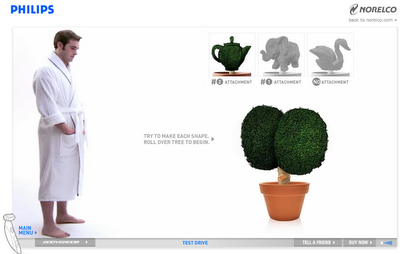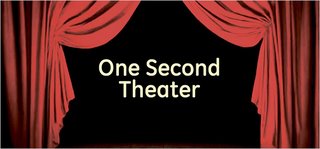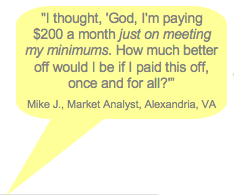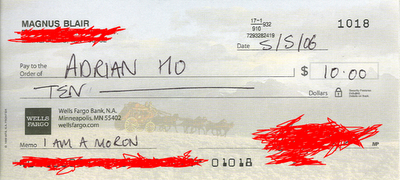
This is really clever, the BBC has rented an island in Second life where it will stage music festivals and other entertainment events. The first is a simulcast of its One Big Weekend festival from Dundee.
The idea sounds better than the implementation, apparently it'll just be streamed video of the acts along with some chances to interact, but I think it's a step in the right direction and shows a willingness to experiment that's really smart.
Share ideas that inspire. FALLON PLANNERS (and co-conspirators) are freely invited to post trends, commentary, obscure ephemera and insightful rants regarding the experience of branding.
Saturday, May 13, 2006
BBC launches festival simultaneously on and offline
Hummer H1 buh bye

The Chron reports that GM has given up on the top-of-the-line Hummer H1 after sales slowed to less than a 100 this year. In an interesting sign of the times it also notes that more Prius' were sold than the entire Hummer line.
Friday, May 12, 2006
How We Buy: Grocerylists.org

Grocerylists.org is compiling just what you think from all across America...
Somewhere is an insight to be gleened or an open opportunity to utilise all these scanned-in scraps to solve a client problem.
I don't know what that great use is just yet...but here's the link anyway.
Who Really Owns 'Smiley'?
BBC reports about the sordid trail of ownership claims to the ubiquitous "Smiley" icon. How could something so full of love be at the core of so much conflict? Free Smiley Now! 
Wal-Mart is embroiled in a legal dispute over the smiley face image which it wants to trademark in the US.
A Frenchman who claims to have invented the yellow smiley face back in 1968 is opposing the US retail giant's move.
For some, the image is a reminder of 1970s counter-culture, for others, a useful shorthand when sending e-mails.
But since 1996, Wal-Mart has used the image in the US on uniforms and promotional signs, and it wants sole rights to it in the US retail sector.
Franklin Loufrani - just one of a number of people who profess to have invented the image - has marketed the sign since the early 1970s.
He and his London-based company SmileyWorld today own the rights to the logo in more than 80 countries around the world.
The US is not included in this list, and SmileyWorld and Wal-Mart are now at loggerheads before the US Patent and Trademark Office.
A final decision is expected in August.
Until now the smiley face had been considered in the public domain in the US, and therefore free for anyone to use.
Wal-Mart spokesman John Simley told the Los Angeles Times that it had not moved to register the trademark until Mr Loufrani had threatened to do so.
"It is kind of ironic that this whole dispute is about a smiley face," said Mr Simley.
"But in the end, it is what it is: it's a mark that we have a tremendous investment in and is very closely identified with our company."
The authorship of the smiley face is hotly disputed.
While Mr Loufrani says he came up with the image in 1968, American Harvey Ball contends that he first designed the logo in 1963.
Mr Ball, a Massachusetts graphic artist, claims he devised the cartoon to cheer up disgruntled staff at a newly merged insurance firm.
Another American, Seattle-based advertiser David Stern, also claims to have invented the image.
Mr Sterns says he devised the sign in 1967 as part of an advertisement campaign for financial services firm Washington Mutual.
Both Mr Ball and Mr Stern further say that they did not think of trademarking the image at the time.
Since the 1970s, the smiley face has been adopted by a number of different groups.
It appears on number plates in the US state of Kentucky, has featured on an American postage stamp and was the unofficial symbol of the late 1980s acid house dance music movement.
The image was also spoofed in the 1994 movie Forest Gump, in which the title character inadvertently comes up with the logo by rubbing his wet and dirty face on a white T-shirt.
A Bullshit Trend

The Freakonomics guys note the preponderance of bullshit out there in the wake of Harry Frankfurt's short, pithy tome On Bullshit.
A sampling:
“My Life in and out of the Rough: The Truth about all the Bullshit you think you know about me.”
“100 Bullshit Jobs … and How to Get Them” by Stanley Bing.
“The Dictionary of Bullshit”
“The Dictionary of Corporate Bullshit,”
“Bullshit Artist: The 9/11 Leadership Myth”
“Bullets, Badges, and Bullshit”
“Another Bullshit Night in Suck City”
“Your Call is Important to us: The Truth about Bullshit.”
“Hello, Lied the Agent: And Other Bullshit You Hear as a Hollywood TV Writer”
Disturbingly, blogger Jeff Jarvis noted a while back that our priggish FCC has seen fit to single out "bullshit" as a verbotten word http://www.buzzmachine.com/index.php/2006/03/28/in-defense-of-bullshit/. Now that's bullshit.
Thursday, May 11, 2006
Google Trend Part Deux - Still got that trademark google speed-to-usefulness going good.
Funny the two new little blue words "google trends" is the first thing that catches planners attention when they go online!
What I love about this, though I guess it's not that different to the other free web tracking services available, is again the sheer google simplicity and what I'd call "Speed to Usefulness".
First thing I clicked on was "flu" because of the ongoing internal debates over friend/client advice about how prepared their families & work places are for a flu/other pandemic of some kind.
Straight away googletrends tells me something interesting/useful and potentially insightful (at least to hypothesize from). It tells me the geographic location of the online news chatter on flu:
1) Jakarta - where Avian Flu is a clear and present danger (sorry, couldn't resist!)
2)Washington - draw from that your own spin smokescreen / real danger conclusions
Love it! - speed-to-usefulness or perhaps for us it's speed-to-insight. Even better, it's not just fast it's free...
Lets start benchmarking all our research tools, and those our clients use on a cost and speed to insight measure. I know already that on many accounts I'd happily dump 90% of the research and put more effort (& simply more sample size) into the truly fruitful remaining 10%.
Less, better done. Not more done poorly.
Which brings me to all the building work I see going on around the city at the moment, and why it's the same sorry story as how most American restaurants operate... but that's another post.
Google Trend slopes separate trends from fads?


Google just launched their new Google Trends along with a bunch of other stuff. Trends lets you see how popular themes are and gives you a historical graph showing volume of searches on a specific topic.
As a test I looked up Arctic Monkeys (one of Magnus' favorite bands)and then Van Hunt (one of mine) to see what the differences are.
The search histories are quite interesting. The Arctic Monkeys slope is a sharp rise followed by a sharp fall, symbolic of a fad, whereas the Van Hunt slope is steadier, perhaps showing something with a more lasting impact.
Of course I don't think this tells you anything else about my music taste versus Magnus' and definitely doesn't speak to any differences in our character or anything deeper like that.
Trend: Conscious Consumption: Tesco Becomes "Better Neighbour"

Not to be outdone by US' Wal-Mart, Tesco went on the offensive against critics that have slammed Britain's biggest supermarket group as an uncaring retail giant by unveiling a 10-point plan to turn it into a "better neighbour".
The strategy promises a wealth of "green" initiatives from cutting its carrier bag usage by 25 per cent over the next two years to championing local and regional produce. It comes two weeks after the group, which made profits of £2.2bn last year, promised to spend £100m on sustainable environmental technology, such as powering its stores' lighting with wind turbines and building the world's "greenest store". The group will spend tens of millions of pounds more on the pledges unveiled yesterday.
Sir Terry Leahy, the chief executive, promised yesterday his plans would not be "high-blown rhetoric, but solid, practical Tesco changes". Cynics seized on the fact that he unveiled the new community strategy one day after the start of a Competition Commission investigation into the supermarket sector that threatens to single Tesco out as the worst culprit of systematic planning and pricing abuse.
With such public pledges about its commitment to local communities - it has made the community one of its top corporate priorities alongside customers, finance, operations and people - Tesco is hoping to avoid the fate that has befallen Wal-Mart in the US, which has been nicknamed the "Bully of Bentonville" (the US town it is from).
Rising antipathy towards Tesco has seen the creation of Tescopoly.com by pressure groups such as Friends of the Earth and War on Want, where consumers can join a campaign against the company. War on Want unveiled a similarly inspired AsdaWatch website yesterday. Tesco's critics dislike its 30% share of the grocery market and its unfettered march into towns and villages across the UK thanks to its push into the convenience store sector.
Sir Terry said yesterday the group would try to be less obtrusive as a neighbour by cutting the number of noisy deliveries at unsociable hours to its small Express outlets. He also promised storefronts that would blend in better with the local setting.
As for addressing criticism that its stores open in places it is not wanted, Sir Terry said Tesco would consult local communities "proactively" from 2007. "This is not a paper exercise. It will be our opportunity to listen and do practical things about concerns," he said.
It is a moot point as to how much more Tesco is doing than its rivals. J Sainsbury launched its first green store in 1999 and has cut the amount of carbon emissions from its stores by 20 per cent since 2000.
The 10-point action plan
Tesco promises to...
1 - Halve the average energy used in all Tesco buildings by 2010 compared with the year 2000.
2 - Double the amount customers recycle at stores by 2008.
3 - Make all carrier bags degradable from September and use 25 per cent fewer bags over next two years.
4 - Put nutritional labelling on all own-brand products by spring 2007.
5 - Help educate parents about healthier food for their children.
6 - Get 2 million people running, cycling or walking in sponsored events leading up to 2012 Olympics.
7 - Be a quieter neighbour by cutting the number of deliveries to Express convenience stores.
8 - More consultation with local communities before building new stores from 2007.
9 - Make it easier for small suppliers to gain access to Tesco.
10 - Sell more local products than any other retailer and introduce regional counters into stores.
via The Independent
The Extra Optical Inch

Norelco is back with a new BodyGroom shaver, which, as far as I know, is a first in honestly addressing MEN'S FULL BODY SHAVING "NEEDS" - that includes the under-attended butt and groin regions. They take on the issues in a humourous double-entendre Maxim-meets-Spike-at-the-pub manner at this website. A suitably-cast smarmy guide counsels men about the product features and leads "test drives" fraught with more entendre.
But I am most impressed with their insight of the "extra optical inch" benefit that the product provides. I think a Golden Brief (no pun intended) is in order for the planner who sourced this unique USP and A) pushed the insight to the client, and B) got it approved by the client. It is clear these guys are pushing less "a fancy new shaver" (e.g. the 6-bladed Gillete Mach 85+Fusion) so much as a male vanity grooming movement. Tough climb perhaps, but these approaches may get them there.
Wednesday, May 10, 2006
Industry: State of the Blogosphere: Corporate Bloggery

Executives Slow to See Value of Corporate Blogging
Corporate blogs take up only a small space in the blogosphere, but awareness is building, however slowly, among senior executives. Makovsky & Company released "The Makovsky 2006 State of Corporate Blogging Survey" with research conducted by Harris Interactive, to determine which corporations are blogging and how concerns about blogging are being handled.
The role of the blogosphere isn't yet fully realized by senior executives at Fortune 1000 companies. Reserved views extend both to blogging and how to respond to blog posts about the company.
Of 150 top-level decision makers surveyed:
•5% said they see corporate blogging as a communications medium
•3% see it as a brand-building technique
•Less than 1% see it as a sales or lead-generation tool.
•62% doubt the credibility of blogs as a communications tool
•74% doubt the credibility of blogs for brand-building
•70% doubt the credibility of blogs as a sales or lead generation channel
•Yet only about 30% of senior executives have a thorough understanding of the term "Internet blog."
Corporate opinions of blogging may be caused by the clash between corporate culture and the relaxed practices of some bloggers. "The culture of blogging places a high value on communiqués that are honest, spontaneous, provocative and sometimes shocking, in contrast to the controlled communications of business," said Robbin Goodman, EVP and partner at Makovsky & Company. "There is a learning curve that needs to take place."
About 1/2 of the respondents say they have policies in place concerning blogging. 77% believe a policy should be in place to handle company-sanctioned blogs.
Senior level executives may not author blogs themselves, but 15% have someone in the organization writing a blog relating to the company or its activities.
Yet interestingly...THE SAME EXECS USE BLOGS TO MONITOR THE PULSE OF THE PUBLIC.
•20% monitor blogs to know when the company appears in the blogosphere
•21% read business-related blogs at least once a week
The data are a result of a nationwide telephone survey of 150 leading executives at Fortune 1000 companies; 144 of whom had heard of the term "corporate blogging."
Get more bloggery here
via ClickZ Stats
Monday, May 08, 2006
Inbox of Immaturity
 ... And for the tenth pick in this year’s NFL draft, the Arizona Cardinals select: This week's winner for immature males you hate to love and love to hate.
... And for the tenth pick in this year’s NFL draft, the Arizona Cardinals select: This week's winner for immature males you hate to love and love to hate.
Currently looking into trademarking I-MOW (Immature Male Of the Week), but running into trouble with the writers of Entourage - Johnny Drama owns the M-O-W (Movie Of the Week).
I just finished reading that paper on Wal-Mart's strategy. Did you see how he chose to "skirt urbanization costs"? Weak stuff Tom. Here are some silly links; no shortcuts.
Keep it real… biatch: http://www.youtube.com/watch?v=2mYaTivlH8A
In case Chorney’s already looking to win next year’s NCAA pool: http://sports.espn.go.com/ncb/bracketology
Yankees Fan Unite: http://www.youtube.com/watch?v=8SXZRUmlWdk&search=Alex%20Rodriguez%20
http://www.whorepresents.com
http://www.expertsexchange.com
http://www.penisland.net
http://www.therapistfinder.com
http://www.powergenitalia.com
http://www.molestationnursery.com
By the way, note the # of YouTube clips vs. other sources of distraction.
Trend: "Don't Panic": When Birds Attack!

This week, ABC airs Fatal Contact: Bird Flu In America - a "drama ripped from today's headlines"!
Hype or warning?
Well, check the White House plans for this possible pandemic which include...very little as usual, just lots of "monitoring" the situation. Although the federal government will stockpile 75 million doses of antiviral drugs and 20 million doses of vaccine to combat any outbreak of pandemic flu, LOCAL GOVERNMENTS AND INDIVIDUAL COMMUNITIES WILL HAVE TO SHOULDER MOST OF THE BURDEN IN BATTLING THE DISEASE.
Translation: you're on your own, suckers!
But don't worry...the US Agriculture Department is developing some effective TV ads featuring some persuasive talking heads and they've even launched some web campaigns to educate and calm. Because really, "Biosecurity is for the birds", people, and nothing like a cartoon chicken from the government to make me feel better about all that silly concern!
So worry or not? Government "experts" assure us that any possible avian flu in America simply will not transfer to humans, anyway. So, I think that is your cue to worry folks...
Meanwhile, producers and fast feeders in the $50 billion a year chicken industry, like McDonald's, El Pollo Loco, Popeyes Chicken & Biscuits, Subway and KFC are now waging a massive marketing-communications program singly and through trade associations to reassure consumers that eating chicken is safe. 

Producers Tyson Foods and Pilgrim's Pride are already suffering slower sales. Pilgrim's Pride plans to cut chicken production by 3% on excess inventory. It reported last week that its U.S. operations saw market pricing in the second quarter fall 30% from a year ago and domestic chicken sales volume drop 4% on lower demand.
Walmart's 32-year growth
This is pretty fascinating, Consumerist has posted a link to a paper that was written by Thomas Holmes at the U of M, which details Walmart's's growth strategy. Counter-intuitively, he shows that Walmart grew by building stores close to existing stores, NOT by spreading them out as you'd think. Putting them close allowed for economies of scale in distribution, advertising and employee costs making up for any possible cannibalization.
Friday, May 05, 2006
Fashion: Clothes Shoppers Fear "Cooties"

New research shows shoppers are much less likely to buy an article of clothing if they think another person has already touched it.
"Consumer contact with products is a double-edged sword. Prior research has shown people like to touch products, but now we've found that they really don't like it if someone else has touched them first," said Dr. Jennifer Argo a professor in the University of Alberta School of Business.
Argo and her colleagues found that not only were shoppers much less inclined to buy a shirt if they believed someone else had already touched it, consumers also indicated that the value of the product had been diminished if they knew it had been touched.
The researchers also determined that "disgust" was the underlying reason for the participants' opinions, and that the level of disgust increased as the perception of the extent to which the article had been touched or tried on also increased.
The results of the research are published this month in the Journal of Marketing.
via Consumer Affairs
One second theater from GE

The NYT is reporting on a new campaign GE has created that embeds 1 second ads within traditional :30s for slowed-down viewing on Tivos and the like. The 1 second ads sound pretty funny, they're behind the scenes looks or outtakes.
The campaign was created by our friends at BBDO and while I have to hand it to David and gang for the bravery and experimentation of this approach, I'm curious about the reasoning behind this. First, it seems out of line with GE's target audience who I'm assuming are primarily the investment community and secondly, I wonder who will be engaged enough with the brand to actually participate.
It does definitely support the GE platform of innovation though.
Thursday, May 04, 2006
Ad supported version of Office soon?

A while ago, Cnet ran a story about Microsoft considering releasing ad supported version of their software. Sounds as if they've made their minds up on this one and that an ad supported, (free or heavily discounted) version of Office is in the works. Buried within a report on MS new ad serving technology - Ad Center (which BTW I think will migrate off the web and onto TV soon) - is the announcement that Ad Center will serve ads not just on MSN search but also on xbox live and Office...
I don't know how users will react to interstitials interrupting them while they're writing memos and presentations, but for some advertisers this could be a godsend as it provides a real link into an extremely valuable daypart that could influence after work sales. I know I've worked on a bunch of different projects from online travel portals to TV dinners where I would have killed to be able to bank on connecting with people while they're working.
I think this is the smartest thing I've heard from Microsoft for ages. They've realized Office isn't an app, it's a network. Brilliant.
CBS jumps on DAV bandwagon
Google Health to launch soon?

According to an entry on USA Today's blog, Google have hinted that a health site may be among a host of new announcements to be made next week. Google Health would be another brilliant move designed to capture masses of advertising dollars as with Boomers set to retire, healthcare spending is predicted to be one of the the only growth areas in the economy.
Trend: Bankrupt!: Debt Freedom Rings

Are we paying down our credit card debts?
Federal Reserve reports that the increase last year in credit card debt and other types of revolving credit was just 2.6 percent, the smallest increase in 23 years (lemme be clear: debt is still increasing - just less-ish). Hmn. Why?
Since my first post on Debt, I've taken a look at reported first quarter earnings - and some of the largest credit card issuers report surprising downturns.
In 1st Quarter’06 Citigroup, J.P. Morgan Chase, Cap One and Amex reported unexpected decreases in outstanding loan balances from U.S. consumer cards. We seem to be paying it down-ish.
•Citigroup showed noticeable declines in "traditional credit products" in the U.S. market, due to "increased payment rates."
(CNNMoney.com and ConsumerAffairs.com)
•JP Morgan Chase showed declines due to "narrower loan spreads as cardholders paid off more and more of their debt.”
(CNNMoney.com and ConsumerAffairs.com)
•Capital One Financial Corp. showed declines “due to the sale of certain charged-off debt, and an improvement in credit quality following the spike in bankruptcy filings last year.”
(CardForum.com)
•AmEx also reported a reduction in finance-charge revenues “because cardholders paid off their bills faster than expected.”
(CardForum.com)
And back in 2005…
•MBNA and Capital One found that "results were further impacted by unexpectedly high payment volumes from U.S. credit card customers," and that "the payment volumes were particularly higher on accounts with higher interest rates.”
(NPR.org and MSN/Slate.com)
According to Dow Jones' MarketWatch, officials at JP Morgan and Citibank admit that these timely payments of outstanding balances present problems for the banks.
Analysts propose this trend may be driven by a combination of exploding gas prices, increasing interest rates, and the tough new bankruptcy laws.
Also a 2005 mandate from the Office of the Comptroller of the Currency now requires banks double the mandatory minimum payment on credit card balances, in order to push consumers to pay off their debt.
Analysts also offer the fact that Americans have stepped up borrowing through home equity loans rather than increasing credit card debt.
But might these be flukes? Can consumers even make good on these starts?
Some polls imply that we have all the best intentions to continue to take steps to reduce credit card debts:
•84% say they are likely to reduce credit card debt in 2006
•7% have a more pessimistic outlook, believing it's "not at all likely" they'll reduce credit card debt
(Experian-Gallup Personal Credit Index, January 2006)
















